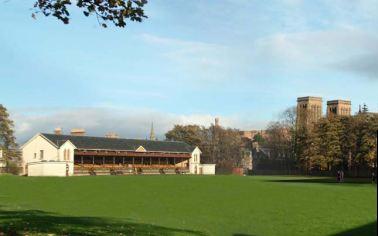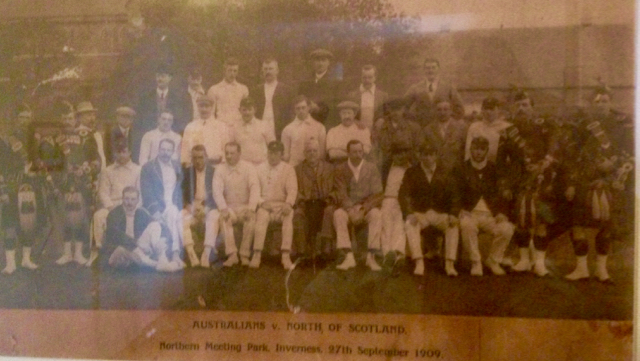 This week’s blog comes from Dr Jim MacPherson, Programme Leader for the MLitt British Studies at the University of the Highlands and Islands.
This week’s blog comes from Dr Jim MacPherson, Programme Leader for the MLitt British Studies at the University of the Highlands and Islands.
I’ve spent much of the summer thinking about (and, occasionally, playing) cricket. And, after a scintillating Ashes series and as another cricket season draws to a close, it’s a good point to reflect on the game I love and how it helps us to understand aspects of British and empire identity.
A few weeks ago, I was fortunate enough to play at the old Northern Meeting Park in Inverness. The grandstand was built in 1864 and for many decades hosted the annual Highland Games in the town. It’s a wonderful spot in which to play cricket, under the shadow of St Andrew’s Cathedral and I’ve never before walked out to bat down the steps of such a fine Victorian pavilion, reminiscent of the great temples of cricket, such as the Sydney Cricket Ground.
 While the picture above captures a fine moment where I’m just about to hit the winning runs for Ross County in our epic tussle against Northern Counties, the highlight of my visit to the Northern Meeting Park came during the tea interval. Aside from the splendid cake, my eye was caught by some photographs which adorned the walls of the Northern Counties’ club room. In amongst all the photos of old teams past lurked this absolute gem:
While the picture above captures a fine moment where I’m just about to hit the winning runs for Ross County in our epic tussle against Northern Counties, the highlight of my visit to the Northern Meeting Park came during the tea interval. Aside from the splendid cake, my eye was caught by some photographs which adorned the walls of the Northern Counties’ club room. In amongst all the photos of old teams past lurked this absolute gem:
Flanked pleasingly by pipers, here we have the Australian Test team, taken just before their ‘hurriedly arranged match’ (as the report in The Scotsman had it) with a team ‘got up by the North of Scotland Cricket League’ in September 1909. This was part of the Australian’s ‘Highland Tour’, which seems to have been something of a reward for their recent series victory against England in the Ashes. In a letter written back home to his relatives while on the return voyage to Australia, Frank Laver wrote about their ‘motoring through the Highlands of Scotland’, enjoying the salmon fishing and what sounds like a rather lavish lunch with the Duke of Sutherland at Dunrobin Castle. The Australian cricketers found time, however, to take part in a ‘benefit’ match for the Inverness club.
A ‘large crowd’ gathered at the Northern Meeting Park, where they would have witnessed a rather bizarre reception (‘unique’, in Laver’s description) for these famous cricketers. The pipers from the above photo formed an escort for the Australian team, meeting them on their arrival, and then leading them on to the pitch!
While the bagpipes and the tartanry which accompanied the Australians’ visit to Inverness may seem at odds with our image of cricket as a quintessentially English sport, this match from 1909 and my more recent one from 2015 tell us much about the far broader range of identities that cricket can embrace and articulate. Indeed, as I stood fielding at deep square leg, I was struck by the juxtaposition of the game I was playing with the sounds of a piper wafting over the ground. So, here I was, playing cricket in Inverness, at the site of the Highland Games for many decades, listening to ‘Scotland the Brave’, where just over a hundred years earlier, the Australian Test cricketers had played.
Cricket becomes, then, a wonderful sporting prism through which to view the multiple nature of British identities. For much of the nineteenth and well into the twentieth centuries, cricket was a sport played throughout the British isles (including Ireland) and the British empire, as Dean Allen’s research tells us. And playing and thinking about cricket in the far north of Scotland helped me to think harder about my favourite sport and the British identities that I spend my working life researching.


07/04/2016 at 1:50 pm
Nice one Jim
Glad you finally got some cricket in too!
LikeLike
07/07/2016 at 1:42 pm
Many thanks, Neil!
LikeLike